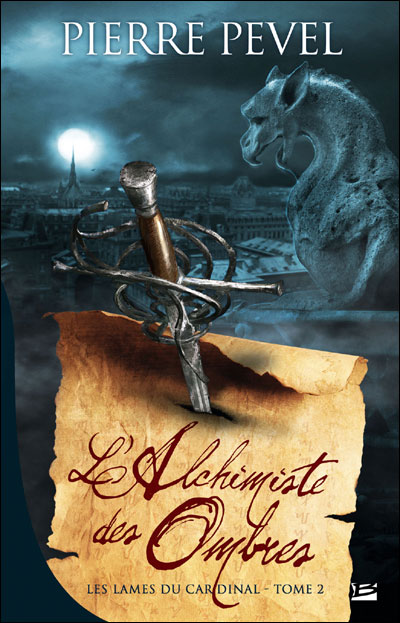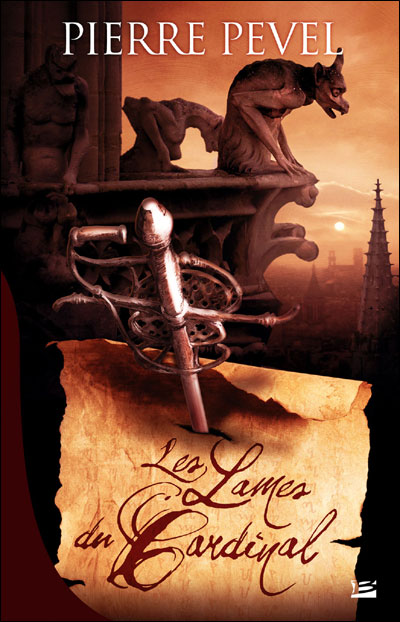Posté : ven. 24 avr. 2009 20:12
D'après le blog de bragelonne, le deuxième tome intitulé L'Alchimiste des Ombres paraîtra en Juin.:)Zedd
Si, tu as raison, j'avais lu une interview où il annonçait pouvoir le sortir à l'automne dernierIl n'était pas prévu à l'automne dernier au départ ?

Je n'ai rien vu dans les plannings.P'tain, je suis dans le second tome ; ça déchire grave.Zeddchri5 a écrit :une date prévue pour une sortie en poche (du 1er tome) ?

fantasy book critic a écrit :November 19, 2009 marks the UK Hardcover & Trade Paperback publication of “The Cardinal’s Blades” via Gollancz. The English version was translated by Tom Clegg. The original French version was published in 2007 by Braglonne.ANALYSIS: If Alexandre Dumas had written a fantasy novel, it would probably look something like Pierre Pevel’s “The Cardinal’s Blades”, which takes Dumas' swashbuckling adventure, intrigue and historical setting, and adds dragons to the mix—think The Three Musketeers meets Naomi Novik’s Temeraire. A cool concept in theory, but does it work? Well, yes and no...On the plus side, “The Cardinal’s Blades” is a lot of fun to read. The action, as promised, is non-stop, driven by short 3-4 page long chapters and multiple subplots; the intrigue is engaging and devious, full of little twists and turns with nearly every character in the book harboring a secret of some sort or hidden allegiance; the cast of characters is extensive, diverse and likeable; humor is light and enjoyable; and some familiar faces appear in the book including Cardinal Richelieu, Comte de Rochefort, and even AthosIn short, “The Cardinal’s Blades” successfully captures the spirit of Alexandre Dumas, and should immediately appeal to anyone who is a fan of swashbuckling adventure.Fantasy lovers however, are not quite as lucky. For while the historical, swashbuckling and intrigue aspects are handled beautifully, the fantasy elements in the book are drastically understated. Yes, there are dragons and magic in “The Cardinal’s Blades” in the form of the Black Claw order, wyverns (racial cousins of the dragons who serve mankind as winged mounts), half-bloods, dragonnets (used as pets or messengers), dracs (a race spawned by the dragons in order to serve them), the ranse disease (originated from dragons), and a Sphère d’ Áme (houses the soul of an Ancestral Dragon), but so little time is spent on fleshing out these elements—a few paragraphs here and there—that they feel more like garnish than an integral part of the novel. This problem also extends to the story which primarily focuses on the machinations between France, Spain, the Cardinal’s Blades and the Black Claw, as opposed to the greater threat in the Court of Dragons. Basically, if the author had spent as much time and effort on developing the fantasy parts of the novel as he did the rest of the book, then “The Cardinal’s Blades” would have been profoundly better.Other problems with the book includes a plot that takes a long time to develop (nearly 180 pages before the Cardinal’s Blades are reformed and their mission revealed); the blunt manner in which the author spells out everything that is happening intrigue-wise, as if it would be too difficult for the reader to folllow—it’s not by the way; and the characterization, or lack thereof. Of the last, because there are so many characters in the novel and because the chapters are so short, very little character development is going on apart from establishing a few main traits: Marciac is roguish and a womanizer, Almades is serious and reserved, La Fargue is the grizzled leader, etc. As a result, it’s very hard to actually care about anyone in the book—they are mostly recognizable stock figures anyway—regardless of how fun their narratives may be. Finally, I found the prose to be surprisingly plain and economical, especially for an award-winning author, although that may be more due to the translation than Pierre Pevel’s actual writing style.CONCLUSION: In the end, Pierre Pevel’s “The Cardinal’s Blades” is a fast and fun reading experience, but is plagued by a few fundamental problems and lacks the substance and depth to be anything more than a good summer read. It’s also a book that I believe will appeal more to fans of Alexandre Dumas, swashbuckling adventures, and alternate histories than those of epic fantasies. Fortunately, being a fan of Dumas myself as well as fantasy, I enjoyed reading “The Cardinal’s Blades” and look forward to continuing the series...